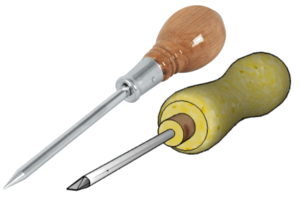Awl and Bradawl: Difference between revisions
From DT Online
(Created Article) |
m (Corrected link) |
||
| Line 1: | Line 1: | ||
[[File:AwlBradawl.png|300px|right]] | [[File:AwlBradawl.png|300px|right]] | ||
The [https://en.wikipedia.org/wiki/Scratch_awl '''Awl'''] is a small hand-held tool with a sharpened point which a woodworker might use to scratch lines along the grain of timber in much the same way as a metalworker would use a '''[[Scriber]]''' - ''(a '''[[Marking Knife]]''' would be used across the grain)''. They are used also to pierce holes in materials such as leather or canvas when stitching for example. | The [https://en.wikipedia.org/wiki/Scratch_awl '''Awl'''] is a small hand-held tool with a sharpened point which a woodworker might use to scratch lines along the grain of timber in much the same way as a metalworker would use a '''[[Pens, Pencils and Scribers|Scriber]]''' - ''(a '''[[Marking Knife]]''' would be used across the grain)''. They are used also to pierce holes in materials such as leather or canvas when stitching for example. | ||
Revision as of 13:33, 28 October 2015
The Awl is a small hand-held tool with a sharpened point which a woodworker might use to scratch lines along the grain of timber in much the same way as a metalworker would use a Scriber - (a Marking Knife would be used across the grain). They are used also to pierce holes in materials such as leather or canvas when stitching for example.
A Bradawl is similar but is flattened at its tip to produce a sharp chisel edge. The cutting edge is first placed across the grain of timber to cut the fibres and rotated backwards and forwards to produce small holes suitable for nails or to start screws.
